<Back to Index>
- Physicist Richard Phillips Feynman, 1918
- Physicist Julian Seymour Schwinger, 1918
- Physicist Sin-Itiro Tomonaga, 1906
PAGE SPONSOR
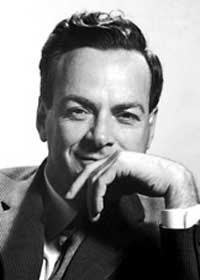
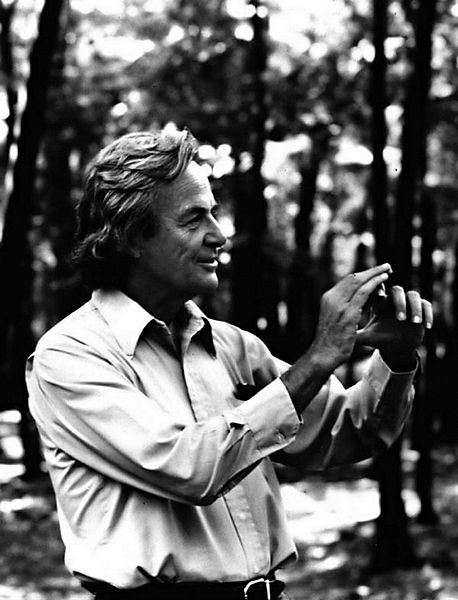
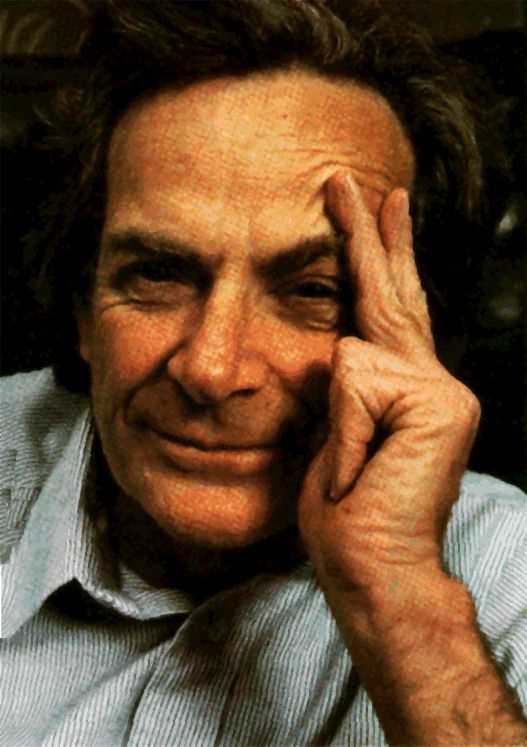
Richard Phillips Feynman (May 11, 1918 – February 15, 1988) was an American theoretical physicist known for his work in the path integral formulation of quantum mechanics, the theory of quantum electrodynamics, and the physics of the superfluidity of supercooled liquid helium, as well as in particle physics (he proposed the parton model). For his contributions to the development of quantum electrodynamics, Feynman, jointly with Julian Schwinger and Sin-Itiro Tomonaga, received the Nobel Prize in Physics in 1965. He developed a widely used pictorial representation scheme for the mathematical expressions governing the behavior of subatomic particles, which later became known as Feynman diagrams.
He assisted in the development of the atomic bomb and was a member of the panel that investigated the Space Shuttle Challenger disaster. In addition to his work in theoretical physics, Feynman has been credited with pioneering the field of quantum computing, and introducing the concept of nanotechnology. He held the Richard Chace Tolman professorship in theoretical physics at the California Institute of Technology.
Feynman was a keen popularizer of physics through both books and lectures, notably a 1959 talk on top - down nanotechnology called, There's Plenty of Room at the Bottom, and the three volume publication of his undergraduate lectures, The Feynman Lectures on Physics. Feynman also became known through his semi - autobiographical books, Surely You're Joking, Mr. Feynman! and What Do You Care What Other People Think?, and books written about him, such as Tuva or Bust!.
He also had a deep interest in biology, and was a friend of the geneticist and microbiologist, Esther Lederberg, who developed replica plating and discovered bacteriophage lambda. They had several mutual physicist friends who, after beginning their careers in nuclear research, moved into genetics, among them Max Delbrück and Aaron Novick.
Richard Phillips Feynman was born on May 11, 1918, in Far Rockaway, Queens, New York, the son of Lucille (née Phillips), a homemaker, and Melville Arthur Feynman, a sales manager. His family originated from Russia and Poland; both of his parents were Ashkenazi Jewish. They were not religious, and by his youth Feynman described himself as an "avowed atheist". Feynman (in common with the famous physicist Edward Teller) was a late talker; by his third birthday he had yet to utter a single word. The young Feynman was heavily influenced by his father, who encouraged him to ask questions to challenge orthodox thinking. From his mother, he gained the sense of humor that he had throughout his life. As a child, he had a talent for engineering, maintained an experimental laboratory in his home, and delighted in repairing radios. His younger sister Joan also became a professional physicist.
In high school, his IQ was determined to be 125 — high, but "merely respectable" according to biographer James Gleick. Feynman later scoffed at psychometric testing. In the year 1933, in which he turned 15, he taught himself trigonometry, advanced algebra, infinite series, analytic geometry, and both differential and integral calculus. Before entering college, he was experimenting with and re-creating mathematical topics, such as the half - derivative, using his own notation. In high school, he was developing the mathematical intuition behind his Taylor series of mathematical operators.
His habit of direct characterization sometimes rattled more conventional thinkers; for example, one of his questions, when learning feline anatomy, was "Do you have a map of the cat?" (referring to an anatomical chart).
Feynman attended Far Rockaway High School, a school also attended by fellow laureates Burton Richter and Baruch Samuel Blumberg. A member of the Arista Honor Society, in his last year in high school, Feynman won the New York University Math Championship; the large difference between his score and those of his closest competitors shocked the judges.
He applied to Columbia University, but was not accepted. Instead he attended the Massachusetts Institute of Technology, where he received a bachelor's degree in 1939, and in the same year was named a Putnam Fellow. While there, Feynman took every physics course offered, including a graduate course on theoretical physics while only in his second year.
He obtained a perfect score on the graduate school entrance exams to Princeton University in mathematics and physics — an unprecedented feat — but did rather poorly on the history and English portions. Attendees at Feynman's first seminar included Albert Einstein, Wolfgang Pauli, and John von Neumann. He received a Ph.D. from Princeton in 1942; his thesis advisor was John Archibald Wheeler. Feynman's thesis applied the principle of stationary action to problems of quantum mechanics, inspired by a desire to quantize the Wheeler – Feynman absorber theory of electrodynamics, laying the groundwork for the "path integral" approach and Feynman diagrams, and was titled "The Principle of Least Action in Quantum Mechanics".
This was Richard Feynman nearing the crest of his powers. At twenty-three … there was no physicist on earth who could match his exuberant command over the native materials of theoretical science. It was not just a facility at mathematics (though it had become clear … that the mathematical machinery emerging from the Wheeler – Feynman collaboration was beyond Wheeler's own ability). Feynman seemed to possess a frightening ease with the substance behind the equations, like Albert Einstein at the same age, like the Soviet physicist Lev Landau — but few others.
— James Gleick, Genius: The Life and Science of Richard Feynman
At Princeton, the physicist Robert R. Wilson encouraged Feynman to participate in the Manhattan Project — the wartime U.S. Army project at Los Alamos developing the atomic bomb. Feynman said he was persuaded to join this effort to build it before Nazi Germany developed their own bomb.
He was assigned to Hans Bethe's theoretical division, and impressed Bethe enough to be made a group leader. He and Bethe developed the Bethe – Feynman formula for calculating the yield of a fission bomb, which built upon previous work by Robert Serber.
He immersed himself in work on the project, and was present at the Trinity bomb test. Feynman claimed to be the only person to see the explosion without the very dark glasses or welder's lenses provided, reasoning that it was safe to look through a truck windshield, as it would screen out the harmful ultraviolet radiation.
As a junior physicist, he was not central to the project. The greater part of his work was administering the computation group of human computers in the theoretical division (one of his students there, John G. Kemeny, later went on to co-design and co-specify the programming language BASIC). Later, with Nicholas Metropolis, he assisted in establishing the system for using IBM punched cards for computation. Feynman succeeded in solving one of the equations for the project that were posted on the blackboards, however, they did not "do the physics right" and Feynman's solution was not used.
Feynman's other work at Los Alamos included calculating neutron equations for the Los Alamos "Water Boiler", a small nuclear reactor, to measure how close an assembly of fissile material was to criticality. On completing this work he was transferred to the Oak Ridge facility, where he aided engineers in devising safety procedures for material storage so that criticality accidents (for example, due to sub-critical amounts of fissile material inadvertently stored in proximity on opposite sides of a wall) could be avoided. He also did theoretical work and calculations on the proposed uranium hydride bomb, which later proved not to be feasible.
Feynman was sought out by physicist Niels Bohr for one - on -one discussions. He later discovered the reason: most of the other physicists were too in awe of Bohr to argue with him. Feynman had no such inhibitions, vigorously pointing out anything he considered to be flawed in Bohr's thinking. Feynman said he felt as much respect for Bohr as anyone else, but once anyone got him talking about physics, he would become so focused he forgot about social niceties.
Due to the top secret nature of the work, Los Alamos was isolated. In Feynman's own words, "There wasn't anything to do there". Bored, he indulged his curiosity by learning to pick the combination locks on cabinets and desks used to secure papers. Feynman played many jokes on colleagues. In one case he found the combination to a locked filing cabinet by trying the numbers he thought a physicist would use (it proved to be 27 – 18 – 28 after the base of natural logarithms, e = 2.71828…), and found that the three filing cabinets where a colleague kept a set of atomic bomb research notes all had the same combination. He left a series of notes in the cabinets as a prank, which initially spooked his colleague, Frederic de Hoffmann, into thinking a spy or saboteur had gained access to atomic bomb secrets. On several occasions, Feynman drove to Albuquerque to see his ailing wife in a car borrowed from Klaus Fuchs, who later was discovered to be a real spy for the Soviets, transporting nuclear secrets in his car to Santa Fe.
On occasion, Feynman would find an isolated section of the mesa where he could drum in the style of American natives; "and maybe I would dance and chant, a little". These antics did not go unnoticed, and rumors spread about a mysterious Indian drummer called "Injun Joe". He also became a friend of the laboratory head, J. Robert Oppenheimer, who unsuccessfully tried to court him away from his other commitments after the war to work at the University of California, Berkeley.
Feynman alludes to his thoughts on the justification for getting involved in the Manhattan project in The Pleasure of Finding Things Out. As mentioned earlier, he felt the possibility of Nazi Germany developing the bomb before the Allies was a compelling reason to help with its development for the U.S. He goes on to say, however, that it was an error on his part not to reconsider the situation once Germany was defeated. In the same publication, Feynman also talks about his worries in the atomic bomb age, feeling for some considerable time that there was a high risk that the bomb would be used again soon, so that it was pointless to build for the future. Later he describes this period as a "depression."
Following the completion of his Ph.D. in 1942, Feynman held an appointment at the University of Wisconsin – Madison as an assistant professor of physics. The appointment was spent on leave for his involvement in the Manhattan project. In 1945, he received a letter from Dean Mark Ingraham of the College of Letters and Science requesting his return to UW to teach in the coming academic year. His appointment was not extended when he did not commit to return. In a talk given several years later at UW, Feynman quipped, "It's great to be back at the only university that ever had the good sense to fire me".
After the war, Feynman declined an offer from the Institute for Advanced Study in Princeton, New Jersey, despite the presence there of such distinguished faculty members as Albert Einstein, Kurt Gödel and John von Neumann. Feynman followed Hans Bethe, instead, to Cornell University, where Feynman taught theoretical physics from 1945 to 1950. During a temporary depression following the destruction of Hiroshima by the bomb produced by the Manhattan Project, he focused on complex physics problems, not for utility, but for self - satisfaction. One of these was analyzing the physics of a twirling, nutating dish as it is moving through the air. His work during this period, which used equations of rotation to express various spinning speeds, soon proved important to his Nobel Prize winning work. Yet because he felt burned out and had turned his attention to less immediately practical, but more entertaining, problems, he felt surprised by the offers of professorships from other renowned universities.
Despite yet another offer from the Institute for Advanced Study, Feynman rejected the Institute on the grounds that there were no teaching duties: Feynman felt that students were a source of inspiration and teaching was a diversion during uncreative spells. Because of this, the Institute for Advanced study and Princeton University jointly offered him a package whereby he could teach at the university and also be at the institute. Feynman instead accepted an offer from the California Institute of Technology (Caltech) — and as he says in his book Surely You're Joking Mr. Feynman! — because a desire to live in a mild climate had firmly fixed itself in his mind while he was installing tire chains on his car in the middle of a snowstorm in Ithaca.
Feynman has been called the "Great Explainer". He gained a reputation for taking great care when giving explanations to his students and for making it a moral duty to make the topic accessible. His guiding principle was that, if a topic could not be explained in a freshman lecture, it was not yet fully understood. Feynman gained great pleasure from coming up with such a "freshman - level" explanation, for example, of the connection between spin and statistics. What he said was that groups of particles with spin ½ "repel", whereas groups with integer spin "clump." This was a brilliantly simplified way of demonstrating how Fermi – Dirac statistics and Bose – Einstein statistics evolved as a consequence of studying how fermions and bosons behave under a rotation of 360°. This was also a question he pondered in his more advanced lectures, and to which he demonstrated the solution in the 1986 Dirac memorial lecture. In the same lecture, he further explained that antiparticles must exist, for if particles had only positive energies, they would not be restricted to a so-called "light cone."
He opposed rote learning or unthinking memorization and other teaching methods that emphasized form over function. He put these opinions into action whenever he could, from a conference on education in Brazil to a State Commission on school textbook selection. Clear thinking and clear presentation were fundamental prerequisites for his attention. It could be perilous even to approach him when unprepared, and he did not forget the fools or pretenders.
During one sabbatical year, he returned to Newton's Principia Mathematica to study it anew; what he learned from Newton, he passed along to his students, such as Newton's attempted explanation of diffraction.
Feynman did significant work while at Caltech, including research in:
- Quantum electrodynamics. The theory for which Feynman won his Nobel Prize is known for its accurate predictions. This theory was begun in the earlier years during Feynman's work at Princeton as a graduate student and continued while he was at Cornell. This work consisted of two distinct formulations, and it is a common error to confuse them or to merge them into one. The first is his path integral formulation, and the second is the formulation of his Feynman diagrams. Both formulations contained his sum over histories method in which every possible path from one state to the next is considered, the final path being a sum over the possibilities (also referred to as sum - over - paths). For a number of years he lectured to students at Caltech on his path integral formulation of quantum theory. The second formulation of quantum electrodynamics (using Feynman diagrams) was specifically mentioned by the Nobel committee. The logical connection with the path integral formulation is interesting. Feynman did not prove that the rules for his diagrams followed mathematically from the path integral formulation. Some special cases were later proved by other people, but only in the real case, so the proofs don't work when spin is involved. The second formulation should be thought of as starting anew, but guided by the intuitive insight provided by the first formulation. Freeman Dyson published a paper in 1949 which, among many other things, added new rules to Feynman's which told how to actually implement Renormalization. Students everywhere learned and used the powerful new tool that Feynman had created. Eventually computer programs were written to compute Feynman diagrams, providing a tool of unprecedented power. It is possible to write such programs because the Feynman diagrams constitute a Formal language with a grammar.
- Physics of the superfluidity of supercooled liquid helium, where helium seems to display a complete lack of viscosity when flowing. Feynman provided a quantum mechanical explanation for the Soviet physicist Lev D. Landau’s theory of superfluidity. Applying the Schrödinger equation to the question showed that the superfluid was displaying quantum mechanical behavior observable on a macroscopic scale. This helped with the problem of superconductivity; however, the solution eluded Feynman. It was solved with the BCS theory of superconductivity, proposed by John Bardeen, Leon Neil Cooper and John Robert Schrieffer.
- A model of weak decay, which showed that the current coupling in the process is a combination of vector and axial currents (an example of weak decay is the decay of a neutron into an electron, a proton, and an anti - neutrino). Although E. C. George Sudarshan and Robert Marshak developed the theory nearly simultaneously, Feynman's collaboration with Murray Gell-Mann was seen as seminal because the weak interaction was neatly described by the vector and axial currents. It thus combined the 1933 beta decay theory of Enrico Fermi with an explanation of parity violation.
He also developed Feynman diagrams, a bookkeeping device which helps in conceptualizing and calculating interactions between particles in spacetime, notably the interactions between electrons and their antimatter counterparts, positrons. This device allowed him, and later others, to approach time reversibility and other fundamental processes. Feynman's mental picture for these diagrams started with the hard sphere approximation, and the interactions could be thought of as collisions at first. It was not until decades later that physicists thought of analyzing the nodes of the Feynman diagrams more closely. Feynman famously painted Feynman diagrams on the exterior of his van.
From his diagrams of a small number of particles interacting in spacetime, Feynman could then model all of physics in terms of the spins of those particles and the range of coupling of the fundamental forces. Feynman attempted an explanation of the strong interactions governing nucleons scattering called the parton model. The parton model emerged as a complement to the quark model developed by his Caltech colleague Murray Gell-Mann. The relationship between the two models was murky; Gell-Mann referred to Feynman's partons derisively as "put-ons". In the mid 1960s, physicists believed that quarks were just a bookkeeping device for symmetry numbers, not real particles, as the statistics of the Omega - minus particle, if it were interpreted as three identical strange quarks bound together, seemed impossible if quarks were real. The Stanford linear accelerator deep inelastic scattering experiments of the late 1960s showed, analogously to Ernest Rutherford's experiment of scattering alpha particles on gold nuclei in 1911, that nucleons (protons and neutrons) contained point - like particles which scattered electrons. It was natural to identify these with quarks, but Feynman's parton model attempted to interpret the experimental data in a way which did not introduce additional hypotheses. For example, the data showed that some 45% of the energy momentum was carried by electrically neutral particles in the nucleon. These electrically neutral particles are now seen to be the gluons which carry the forces between the quarks and carry also the three - valued color quantum number which solves the Omega-minus problem. Feynman did not dispute the quark model; for example, when the fifth quark was discovered in 1977, Feynman immediately pointed out to his students that the discovery implied the existence of a sixth quark, which was duly discovered in the decade after his death.
After the success of quantum electrodynamics, Feynman turned to quantum gravity. By analogy with the photon, which has spin 1, he investigated the consequences of a free massless spin 2 field, and was able to derive the Einstein field equation of general relativity, but little more. However, the computational device that Feynman discovered then for gravity, "ghosts", which are "particles" in the interior of his diagrams which have the "wrong" connection between spin and statistics, have proved invaluable in explaining the quantum particle behavior of the Yang – Mills theories, for example, QCD and the electro - weak theory.
In 1965, Feynman was appointed a foreign member of the Royal Society. At this time in the early 1960s, Feynman exhausted himself by working on multiple major projects at the same time, including a request, while at Caltech, to "spruce up" the teaching of undergraduates. After three years devoted to the task, he produced a series of lectures that eventually became the Feynman Lectures on Physics, one reason that Feynman is still regarded as one of the greatest teachers of physics. He wanted a picture of a drumhead sprinkled with powder to show the modes of vibration at the beginning of the book. Concerned over the connections to drugs and rock and roll that could be made from the image, the publishers changed the cover to plain red, though they included a picture of him playing drums in the foreword. The Feynman Lectures on Physics occupied two physicists, Robert B. Leighton and Matthew Sands, as part time co-authors for several years. Even though the books were not adopted by most universities as textbooks, they continue to sell well because they provide a deep understanding of physics. As of 2005, The Feynman Lectures on Physics has sold over 1.5 million copies in English, an estimated 1 million copies in Russian, and an estimated half million copies in other languages. Many of his lectures and miscellaneous talks were turned into other books, including The Character of Physical Law, QED: The Strange Theory of Light and Matter, Statistical Mechanics, Lectures on Gravitation, and the Feynman Lectures on Computation. Feynman later won the Oersted Medal for teaching, of which he seemed especially proud.
Feynman's students competed keenly for his attention; he was once awakened when a student solved a problem and dropped it in his mailbox; glimpsing the student sneaking across his lawn, he could not go back to sleep, and he read the student's solution. The next morning his breakfast was interrupted by another triumphant student, but Feynman informed him that he was too late.
Partly as a way to bring publicity to progress in physics, Feynman offered $1000 prizes for two of his challenges in nanotechnology, claimed by William McLellan and Tom Newman, respectively. He was also one of the first scientists to conceive the possibility of quantum computers.
In 1974, Feynman delivered the Caltech commencement address on the topic of cargo cult science, which has the semblance of science, but is only pseudoscience due to a lack of "a kind of scientific integrity, a principle of scientific thought that corresponds to a kind of utter honesty" on the part of the scientist. He instructed the graduating class that "The first principle is that you must not fool yourself — and you are the easiest person to fool. So you have to be very careful about that. After you've not fooled yourself, it's easy not to fool other scientists. You just have to be honest in a conventional way after that."
In 1984 – 86, he developed a variational method for the approximate calculation of path integrals which has led to a powerful method of converting divergent perturbation expansions into convergent strong - coupling expansions (variational perturbation theory) and, as a consequence, to the most accurate determination of critical exponents measured in satellite experiments.
In the late 1980s, according to "Richard Feynman and the Connection Machine", Feynman played a crucial role in developing the first massively parallel computer, and in finding innovative uses for it in numerical computations, in building neural networks, as well as physical simulations using cellular automata (such as turbulent fluid flow), working with Stephen Wolfram at Caltech. His son Carl also played a role in the development of the original Connection Machine engineering; Feynman influencing the interconnects while his son worked on the software.
Feynman diagrams are now fundamental for string theory and M-theory, and have even been extended topologically. The world - lines of the diagrams have developed to become tubes to allow better modeling of more complicated objects such as strings and membranes. Shortly before his death, however, Feynman criticized string theory in an interview: "I don't like that they're not calculating anything," he said. "I don't like that they don't check their ideas. I don't like that for anything that disagrees with an experiment, they cook up an explanation — a fix-up to say, ‘Well, it still might be true.'" These words have since been much quoted by opponents of the string - theoretic direction for particle physics.
Feynman played an important role on the Presidential Rogers Commission, which investigated the Challenger disaster. During a televised hearing, Feynman demonstrated that the material used in the shuttle's O-rings became less resilient in cold weather by compressing a sample of the material in a clamp and immersing it in ice - cold water. The commission ultimately determined that the disaster was caused by the primary O-ring not properly sealing due to extremely cold weather at Cape Canaveral.
Feynman devoted the latter half of his book What Do You Care What Other People Think? to his experience on the Rogers Commission, straying from his usual convention of brief, light hearted anecdotes to deliver an extended and sober narrative. Feynman's account reveals a disconnect between NASA's engineers and executives that was far more striking than he expected. His interviews of NASA's high ranking managers revealed startling misunderstandings of elementary concepts. For instance, NASA managers claimed that there was a 1 in 100,000 chance of a catastrophic failure aboard the shuttle, but Feynman discovered that NASA's own engineers estimated the chance of a catastrophe at closer to 1 in 100. He concluded that the space shuttle reliability estimate by NASA management was fantastically unrealistic, and he was particularly angered that NASA used these figures to recruit Christa McAuliffe into the Teacher - in - Space program. He warned in his appendix to the commission's report (which was included only after he threatened not to sign the report), "For a successful technology, reality must take precedence over public relations, for nature cannot be fooled." He also rebuked some mathematicians for their exclusivity, saying "I have great suspicion that [mathematicians] don't know that this stuff is wrong and that they're intimidating people."
Although born to and raised by parents who were Ashkenazi, Feynman was not only an atheist, but declined to be labelled Jewish on supposedly "ethnic" grounds. He routinely refused to be included in lists or books that classified people by race. He asked to not be included in Tina Levitan's The Laureates: Jewish Winners of the Nobel Prize, writing, "To select, for approbation the peculiar elements that come from some supposedly Jewish heredity is to open the door to all kinds of nonsense on racial theory," and adding "…at thirteen I was not only converted to other religious views, but I also stopped believing that the Jewish people are in any way 'the chosen people'".
While researching for his Ph.D., Feynman married his first wife, Arline Greenbaum (often misspelled, Arlene). She was diagnosed with tuberculosis, but she and Feynman were careful, and he never contracted it. She succumbed to the disease in 1945. In 1946 Feynman wrote a letter to her, but kept it sealed for the rest of his life. This portion of Feynman's life was portrayed in the 1996 film Infinity, which featured Feynman's daughter, Michelle, in a cameo role.
He was married a second time in June 1952, to Mary Louise Bell of Neodesha, Kansas; this marriage was brief and unsuccessful:
He begins working calculus problems in his head as soon as he awakens. He did calculus while driving in his car, while sitting in the living room, and while lying in bed at night.—Mary Louise Bell divorce complaint
He later married Gweneth Howarth from Ripponden, Yorkshire, who shared his enthusiasm for life and spirited adventure. Besides their home in Altadena, California, they had a beach house in Baja California, purchased with the prize money from Feynman's Nobel Prize, his one third share of $55,000. They remained married until Feynman's death. They had a son, Carl, in 1962, and adopted a daughter, Michelle, in 1968.
Feynman had a great deal of success teaching Carl, using, for example, discussions about ants and Martians as a device for gaining perspective on problems and issues. He was surprised to learn that the same teaching devices were not useful with Michelle. Mathematics was a common interest for father and son; they both entered the computer field as consultants and were involved in advancing a new method of using multiple computers to solve complex problems — later known as parallel computing. The Jet Propulsion Laboratory retained Feynman as a computational consultant during critical missions. One co-worker characterized Feynman as akin to Don Quixote at his desk, rather than at a computer workstation, ready to do battle with the windmills.
Feynman traveled widely, notably to Brazil, where he gave courses at the CBPF (Brazilian Center for Physics Research) and near the end of his life schemed to visit the Russian land of Tuva, a dream that, because of Cold War bureaucratic problems, never became reality. The day after he died, a letter arrived for him from the Soviet government, giving him authorization to travel to Tuva. Out of his enthusiastic interest in reaching Tuva came the phrase "Tuva or Bust" (also the title of a book about his efforts to get there), which was tossed about frequently amongst his circle of friends in hope that they, one day, could see it firsthand. The documentary movie, Genghis Blues, mentions some of his attempts to communicate with Tuva, and chronicles the successful journey there by his friends.
Responding to Hubert Humphrey's congratulation for his Nobel Prize, Feynman admitted to a long admiration for the then vice president. In a letter to an MIT professor dated December 6, 1966, Feynman expressed interest in running for the governor of California.
Feynman took up drawing at one time and enjoyed some success under the pseudonym, "Ofey", culminating in an exhibition dedicated to his work. He learned to play a metal percussion instrument (frigideira) in a samba style in Brazil, and participated in a samba school.
In addition, he had some degree of synesthesia for equations, explaining that the letters in certain mathematical functions appeared in color for him, even though invariably printed in standard black - and - white.
According to Genius, the James Gleick authored biography, Feynman tried LSD during his professorship at Caltech. Somewhat embarrassed by his actions, Feynman largely sidestepped the issue when dictating his anecdotes; he mentions it in passing in the "O Americano, Outra Vez" section, while the "Altered States" chapter in Surely You're Joking, Mr. Feynman! describes only marijuana and ketamine experiences at John Lilly's famed sensory deprivation tanks, as a way of studying consciousness. Feynman gave up alcohol when he began to show early signs of alcoholism, as he did not want to do anything that could damage his brain — the same reason given in "O Americano, Outra Vez" for his reluctance to experiment with LSD.
In Surely You're Joking, Mr. Feynman!, he gives advice on the best way to pick up a girl in a hostess bar. At Caltech, he used a nude or topless bar as an office away from his usual office, making sketches or writing physics equations on paper placemats. When the county officials tried to close the place, all visitors except Feynman refused to testify in favor of the bar, fearing that their families or patrons would learn about their visits. Only Feynman accepted, and in court, he affirmed that the bar was a public need, stating that craftsmen, technicians, engineers, common workers, "and a physics professor" frequented the establishment. While the bar lost the court case, it was allowed to remain open as a similar case was pending appeal.
Feynman has a minor acting role in the film Anti-Clock. He is credited as, "The Professor."
Feynman developed two rare forms of cancer, liposarcoma and Waldenström's macroglobulinemia, dying shortly after a final attempt at surgery for the former on February 15, 1988, aged 69. His last recorded words are noted as, "I'd hate to die twice. It's so boring."
Alan Alda, the stage, screen and television actor, studied writings about Richard Feynman's life during the 1990s in preparation for playing the role of Feynman on stage. Based upon Alda's research, playwright Peter Parnell was commissioned by Alda to write a two - character play about a fictional day in the life of Feynman set two years prior to Feynman's death. The play, entitled, QED, premiered at the Mark Taper Forum in Los Angeles, California in 2001. The play was then presented at the Vivian Beaumont Theatre on Broadway, with both presentations starring Alan Alda as Richard Feynman.
On May 4, 2005, the United States Postal Service issued the American Scientists commemorative set of four 37 cent self - adhesive stamps in several configurations. The scientists depicted were Richard Feynman, John von Neumann, Barbara McClintock and Josiah Willard Gibbs. Feynman's stamp, sepia toned, features a photograph of a 30 - something Feynman and eight small Feynman diagrams. The stamps were designed by artist Victor Stabin under the direction of U.S. Postal Service art director Carl T. Herrman.
The main building for the Computing Division at Fermilab is named the "Feynman Computing Center" in his honor.
The principal character in Thomas A. McMahon's 1970 novel, Principles of American Nuclear Chemistry: A Novel, is modeled on Feynman.
Real Time Opera premiered its opera Feynman at the Norfolk (CT) Chamber Music Festival in June 2005.
In February 2008 LA Theatre Works released a recording of 'Moving Bodies' with Alfred Molina in the role of Richard Feynman. This radio play written by playwright Arthur Giron is an interpretation on how Feynman became one of the iconic American scientists and is loosely based on material found in Surely You're Joking, Mr. Feynman! and What Do You Care What Other People Think?.
On the twentieth anniversary of Feynman's death, composer Edward Manukyan dedicated a piece for solo clarinet to his memory. It was premiered by Doug Storey, the principal clarinetist of the Amarillo Symphony.
In 2009 – 11, clips of an interview with Feynman were used by composer John Boswell as part of the Symphony of Science project in the second, fifth, seventh, and eleventh installments of his videos, "We Are All Connected", "The Poetry of Reality", "A Wave of Reason", and "The Quantum World".
In 1998, a photograph of Richard Feynman giving a lecture was part of the poster series commissioned by Apple Computer for their "Think Different" advertising campaign.
In 2011 Feynman was the subject of a biographical graphic novel entitled simply, Feynman, written by Jim Ottaviani and illustrated by Leland Myrick.
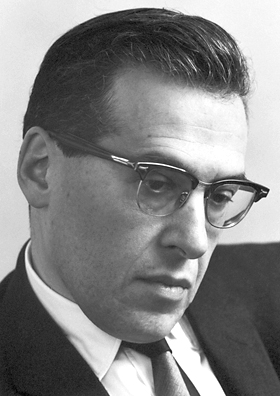
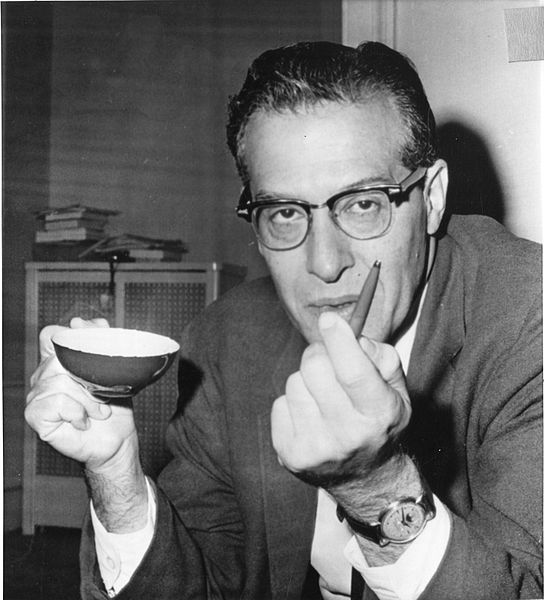
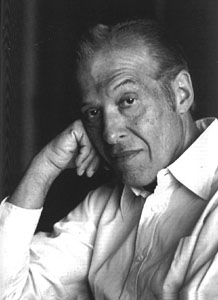
Julian Seymour Schwinger (February 12, 1918 – July 16, 1994) was an American theoretical physicist. He is best known for his work on the theory of quantum electrodynamics (QED), in particular for developing a relativistically invariant perturbation theory, and for renormalizing QED to one loop order.
Schwinger is recognized as one of the greatest physicists of the twentieth century, responsible for much of modern quantum field theory, including a variational approach, and the equations of motion for quantum fields. He developed the first electroweak model, and the first example of confinement in 1+1 dimensions. He is responsible for the theory of multiple neutrinos, Schwinger terms, and the theory of the spin 3/2 field.
Julian Seymour Schwinger was born in New York City, to a Polish Jewish family, who had immigrated to America. Both his father and his mother's parents were prosperous clothing manufacturers, although the family business declined after the 1929 Wall Street Crash. The family followed the Orthodox Jewish tradition. He attended Townsend Harris High School and then the City College of New York as an undergraduate before transferring to Columbia University, where he received his B.A. in 1936 and his Ph.D. (overseen by I.I. Rabi) in 1939 at the age of 21. He worked at the University of California, Berkeley (under J. Robert Oppenheimer), and was later appointed to a position at Purdue University.
After having worked with Oppenheimer, Schwinger's first regular academic appointment was at Purdue University in 1941. While on leave from Purdue, he worked at the Radiation Laboratory at MIT instead of at the Los Alamos National Laboratory during World War II. He provided theoretical support for the development of radar. After the war, Schwinger left Purdue for Harvard University, where he taught from 1945 to 1974.
Schwinger developed an affinity for Green's functions from his radar work, and he used these methods to formulate quantum field theory in terms of local Green's functions in a relativistically invariant way. This allowed him to calculate unambiguously the first corrections to the electron magnetic moment in quantum electrodynamics. Earlier non-covariant work had arrived at infinite answers, but the extra symmetry in his methods allowed Schwinger to isolate the correct finite corrections. Schwinger developed renormalization, formulating quantum electrodynamics unambiguously to one-loop order.
In the same era, he introduced non - perturbative methods into quantum field theory, by calculating the rate at which electron - positron pairs are created by tunneling in an electric field, a process now known as the "Schwinger effect". This effect could not be seen in any finite order in perturbation theory.
Schwinger's foundational work on quantum field theory constructed the modern framework of field correlation functions and their equations of motion. His approach started with a quantum action and allowed bosons and fermions to be treated equally for the first time, using a differential form of Grassman integration. He gave elegant proofs for the spin - statistics theorem and the CPT theorem, and noted that the field algebra led to anomalous Schwinger terms in various classical identities, because of short distance singularities. These were foundational results in field theory, instrumental for the proper understanding of anomalies.
In other notable early work, Rarita and Schwinger formulated the abstract Pauli and Fierz theory of the spin 3/2 field in a concrete form, as a vector of Dirac spinors. In order for the spin-3/2 field to interact consistently, some form of supersymmetry is required, and Schwinger later regretted that he had not followed up on this work far enough to discover supersymmetry.
Schwinger discovered that neutrinos come in multiple varieties, one for the electron and one for the muon. Nowadays there are known to be three light neutrinos; the third is the partner of the tau lepton.
In the 1960s, Schwinger formulated and analyzed what is now known as the Schwinger model, quantum electrodynamics in one space and one time dimension, the first example of a confining theory. He was also the first to suggest an electroweak gauge theory, an SU(2) gauge group spontaneously broken to electromagnetic U(1) at long distances. This was extended by his student Sheldon Glashow into the accepted pattern of electroweak unification. He attempted to formulate a theory of quantum electrodynamics with point magnetic monopoles, a program which met with limited success because monopoles are strongly interacting when the quantum of charge is small.
Having supervised more than seventy doctoral dissertations, Schwinger is known as one of the most prolific graduate advisors in physics. Four of his students won Nobel prizes: Roy Glauber, Benjamin Roy Mottelson, Sheldon Glashow and Walter Kohn (in chemistry).
Schwinger had a mixed relationship with his colleagues, largely because of his source theory. Schwinger considered source theory as a substitute for field theory, although it is only a different point of view, a version of effective field theory. It treats quantum fields as long distance phenomena, and does not require a well defined continuum limit. Source theory was considered overly formal and lacking in distinctness from quantum field theory, and the criticisms by his Harvard colleagues led Schwinger to leave the faculty in 1972 for UCLA. It is a story widely told that Steven Weinberg, who inherited Schwinger's paneled office in Lyman Laboratory, there found a pair of old shoes, with the implied message, "think you can fill these?". At UCLA, and for the rest of his career, Schwinger continued to develop source theory reformulations of quantum field theoretic results.
After 1989 Schwinger took a keen interest in the non - mainstream research of cold fusion. He wrote eight theory papers about it. He resigned from the American Physical Society after their refusal to publish his papers. He felt that cold fusion research was being suppressed and academic freedom violated. He wrote: "The pressure for conformity is enormous. I have experienced it in editors’ rejection of submitted papers, based on venomous criticism of anonymous referees. The replacement of impartial reviewing by censorship will be the death of science."
In his last publications, Schwinger proposed a theory of sonoluminescence as a long distance quantum radiative phenomenon associated not with atoms, but with fast moving surfaces in the collapsing bubble, where there are discontinuities in the dielectric constant. Standard explanations, now supported by experiments, focus on superheated gas atoms inside the bubble as the source of the light, but Schwinger's methods tie back to his old quantum electrodynamic papers.
Schwinger was jointly awarded the Nobel Prize in Physics in 1965 for his work on quantum electrodynamics (QED), along with Richard Feynman and Shinichiro Tomonaga. Schwinger's awards and honors were numerous even before his Nobel win. They include the first Albert Einstein Award (1951), the U.S. National Medal of Science (1964), honorary D.Sc. degrees from Purdue University (1961) and Harvard University (1962), and the Nature of Light Award of the U.S. National Academy of Sciences (1949).
As a famous physicist, Schwinger was often compared to another legendary physicist of his generation, Richard Feynman. Schwinger was more formally inclined and favored symbolic manipulations in quantum field theory. He worked with local field operators, and found relations between them, and he felt that physicists should understand the algebra of local fields, no matter how paradoxical it was. By contrast, Feynman was more intuitive, believing that the physics could be extracted entirely from the Feynman diagrams, which gave a particle picture. Schwinger commented on Feynman diagrams in the following way,
| “ | Like the silicon chips of more recent years, the Feynman diagram was bringing computation to the masses. | ” |
Schwinger disliked Feynman diagrams because he felt that they made the student focus on the particles and forget about local fields, which in his view inhibited understanding. He went so far as to ban them altogether from his class, although he understood them perfectly well and was observed to use them in private.
Despite sharing the Nobel Prize, Schwinger and Feynman had a different approach to quantum electrodynamics and to quantum field theory in general. Feynman used a regulator, while Schwinger was able to formally renormalize to one loop without an explicit regulator. Schwinger believed in the formalism of local fields, while Feynman had faith in the particle paths. They followed each other's work closely, and each respected the other. On Feynman's death, Schwinger described him as
| “ | An honest man, the outstanding intuitionist of our age, and a prime example of what may lie in store for anyone who dares to follow the beat of a different drum. | ” |
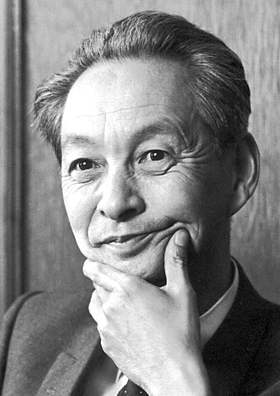
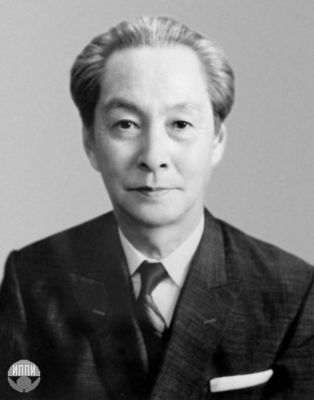
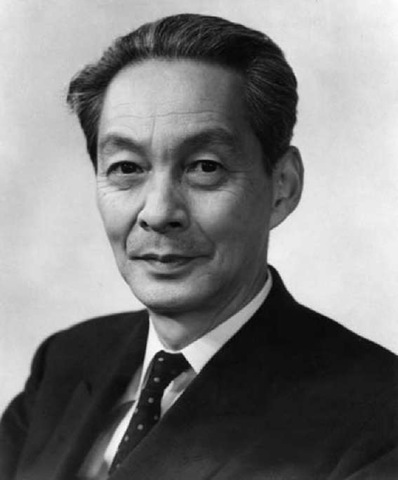
Sin-Itiro Tomonaga or Shin'ichirō Tomonaga (朝永 振一郎 Tomonaga Shin'ichirō, March 31, 1906 – July 8, 1979) was a Japanese physicist, influential in the development of quantum electrodynamics, work for which he was jointly awarded the Nobel Prize in Physics in 1965 along with Richard Feynman and Julian Schwinger.
Tomonaga was born in Tokyo in 1906. He was the second child and eldest son of a Japanese philosopher, Sanjūrō Tomonaga. He entered the Kyoto Imperial University in 1926. Hideki Yukawa, also a Nobel Prize winner, was one of his classmates during undergraduate school. During graduate school at the same university, he worked as an assistant in the university for three years. After graduate school, he joined Nishina's group in Riken. In 1937, while working in Leipzig, he collaborated with the research group of Werner Heisenberg. Two years later, he returned to Japan due to the outbreak of the Second World War, but finished his doctoral degree on the study of nuclear materials with his thesis on work he had done while in Leipzig.
In Japan, he was appointed to a professorship in the Tokyo University of Education (a forerunner of Tsukuba University). During the war he studied the magnetron, meson theory and his "super - many - time" theory. In 1948, he and his students re-examined a 1939 paper by Sidney Dancoff that attempted, but failed, to show that the infinite quantities that arise in QED can be canceled with each other. Tomonaga applied his super - many - time theory and a relativistic method based on the non - relativistic method of Wolfgang Pauli and Fierz to greatly speed up and clarify the calculations. Then he and his students found that Dancoff had overlooked one term in the perturbation series. With this term, the theory gave finite results; thus Tomonaga discovered the renormalization method independently of Julian Schwinger and calculated physical quantities such as the Lamb shift at the same time.
In the next year, he was invited by Robert Oppenheimer to work at the Institute for Advanced Study in Princeton Township. He studied a many - body problem on the collective oscillations of a quantum - mechanical system. In the following year, he returned to Japan and proposed the Tomonaga - Luttinger liquid. In 1965, he was awarded the Nobel Prize in Physics, with Julian Schwinger and Richard P. Feynman, for the study of QED, specifically for the discovery of the renormalization method. He died of throat cancer in Tokyo in 1979.
Tomonaga was married in 1940 to Ryoko Sekigushi. They had two sons and one daughter. He was awarded the Order of Culture in 1952, and the Grand Cordon of the Order of the Rising Sun in 1976.